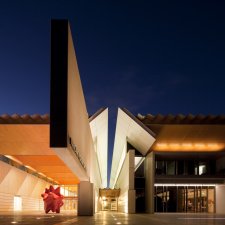- About us
- Support the Gallery
- Venue hire
- Publications
- Research library
- Organisation chart
- Employment
- Contact us
- Make a booking
- Onsite programs
- Online programs
- School visit information
- Learning resources
- Little Darlings
- Professional learning
Olive Cotton (1911-2003) was one of Australia's pioneering modernist photographers. Cotton's lifelong obsession with photography began with the gift of her first camera, a Kodak Box Brownie, when she was eleven. She was a childhood friend of Max Dupain's, and in 1934 she joined his fledgling photographic studio, where she made her best-known work, the angular composition Teacup Ballet, in about 1935. Between 1939 and 1941 Dupain and Cotton were married, and she photographed him often; her Max After Surfing is frequently cited as one of the most sensuous Australian portrait photographs. While Dupain was on service during World War 2 Cotton ran his studio, one of a handful of women working as professional photographers in Australia. After the war she moved to a property near Cowra, NSW, where she lived for the rest of her life with her husband Ross McInerney. Although preoccupied with family and farm, Cotton continued to take photographs and in 1964 opened a studio in Cowra; according to her daughter, 'her photographs were always very important to her, but almost secretly.' In the early 1980s an Australia Council grant spurred Cotton to reprint negatives that she had taken over a period of forty years or more. The resulting retrospective exhibition in Sydney in 1985 drew critical acclaim, and her reputation has since been assured.
Collection: National Portrait Gallery
Purchased 2011
© Lorrie Graham



On one level The Companion talks about the most famous and frontline Australians, but on another it tells us about ourselves.



Visit us, learn with us, support us or work with us! Here’s a range of information about planning your visit, our history and more!



We depend on your support to keep creating our programs, exhibitions, publications and building the amazing portrait collection!